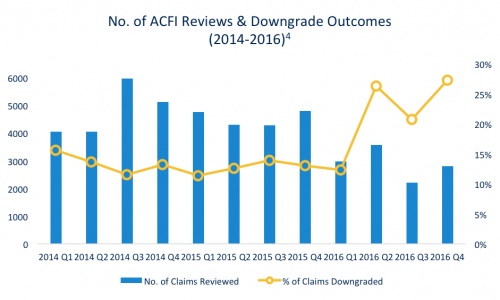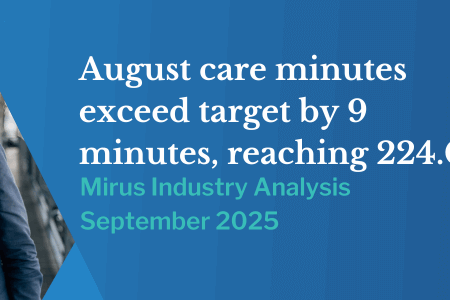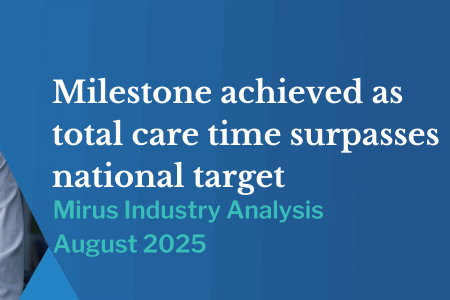22% of ACFI claims reviewed in 2016 were downgraded
May 23, 2017 | Aged Care Finance

Sustainability in a Challenging Environment
For Residential Aged Care Providers, 61% of total revenue comes from Commonwealth care subsidies and supplements1. Most of this funding allocation comes through the Aged Care Funding Instrument (ACFI).
When it comes to the management of ACFI funding, ensuring the quality of the documentation required to support an ACFI claim is crucial. Compiling the supporting pack is a time-consuming process, however the expectations placed on Providers around documentation have further increased.
As part of the 2016-17 budget, the government announced funding cuts of $1.2 billion over four years to the Aged Care sector. A substantial portion of these cuts will be achieved through an overhaul of ACFI – the result of which became effective earlier this year. In addition to the redesign of the ACFI framework, the way claims are audited has also changed. The government promised more robust validations and have adjusted some aspects of the way review visits are conducted.
- Firstly, in April 2017 the Department announced via newsletter they would be “taking a more proportionate approach, based on relative risk, to ACFI reviews”2. This means a service can expect more frequent and more comprehensive validations if they are deemed to be at a higher risk of inaccurate claiming.
- Increasingly as well, providers are given less notice period before a review and the reviews are more in depth. As a result, there is less time to prepare for a review and more documented evidence in support of claims is required.
- In addition, review officers are no longer actively asking for additional evidence after the review visit is completed3. To avoid a claim being downgraded, the responsibility to submit further evidence now lies with the provider.
- Finally, the process to submit requests for reconsideration has been standardised, and a fee of $375 applied, to “encourage approved providers to comply with the record keeping requirements of the Aged Care Act”3.
Validation Insights
Looking at the figures released by the Department of Health, we can already see the effects of this shifting approach to validations. The number of reviews completed over the second half of 2016 decreased by 41% when compared to the same period in 2015 (Fig 1.1). This is in stark contrast to the national downgrade rate which has increased by more than 50% from 13% in Q4 2015 to 27% in Q4 2016 (Fig 1.1). In other words, the Department is conducting fewer reviews but downgrading more.

Whilst the approach to each validation will be different, we are seeing some other trends emerging.
Over the last 12 months, we’ve experienced an increase in care recipient observation and staff interviews. Observation typically starts immediately after the entry meeting. Review officers will often request to observe care recipients prior to reviewing ACFI packs. Staff interviews serve to answer any queries or discrepancies between documentation and observation.
Additionally, the changes to the requirements for some Complex Health Care procedures mean this domain has been a key focus area during recent audits. Some common examples which have been closely monitored include:
- When claiming 12.12a, there must be both a diagnosis of arthritic joints and associated oedema
- For 12.12b the directive must be for use of compression garments and/or compression bandages. Use of tubular elasticised support bandages will lead to a downgrade
- Detailed review of pain management treatments, including timing and method of delivery
At Mirus, we’ve supported clients across Australia at hundreds of validations. Getting ready for a successful validation outcome means being proactive, standardising your process and upskilling your team. In doing so risk is mitigated and the rush of last-minute preparations can be avoided.
We have identified three phases of a validation and some of the steps that can support a sustainable ACFI process.
As with accreditation, one thing we can be sure of is government funding will be audited. However, by embedding a process that supports ongoing quality of ACFI packs, validations don’t necessarily need to be a stressful experience.
At Mirus Australia we work hard to help Aged Care Providers do more for their residents and expect better business outcomes. We partner with our clients to help them refine processes, upskill their teams and improve the financial health of their organisation
Contact us to learn how our clients benefit from the support we provide before, during and after a validation on
info@mirusaustralia.com
PH: 1300 738 145
References
1 . The Fourth Report on the Funding and Financing of the Aged Care Sector (2016), Aged Care Financing Authority.
- Department of Health, Information for Aged Care Providers Newsletter, Issue 2016/6
- Department of Health (Ageing and Aged Care), Amendments to ACFI – 1 March 2017 https://agedcare.health.gov.au/amendments-to-acfi-1-march-2017
- Department of Health (Ageing and Aged Care), ACFI Quarterly Reports (2014-2016)


